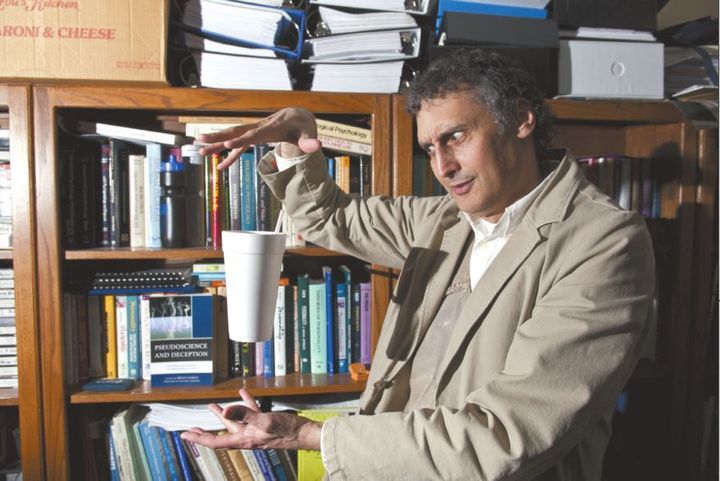
There seems to be a proliferation of “paranormal” television shows and movies in recent years.. A HuffPost word search reveals at least 20 UFO posts currently—which is a microcosm of the much bigger picture. It prompted me to re-read a Forum submission I wrote in 1996—published in Skeptical Inquirer—that illuminated the importance of how to properly perceive allegedly paranormal phenomena—specifically UFO’s in this case. I was surprised to realize how timeless and applicable it still is today so I decided to share it in the HuffPost. Here it is: [reprinted with permission] ..............
Bryan Farha
Skeptical Inquirer, Volume 20.1, January/February 1996
Imagine you live in the small city of Salina, Kansas. As is typical of Kansas weather, it is a fairly windy morning. There is much debris blowing in your front yard, including leaves, branches, and twigs; the children’s toys; and garbage resulting from the trash container having been blown over.
On the lawn of your residence, about twenty feet from your doorstep, you see what looks like a newspaper amongst all the debris. Because of the adverse conditions, it is somewhat difficult to clearly see the print on the paper. But you do not subscribe to the local newspaper. Upon further inspection, and to your absolute bewilderment, you seem to be able to make out the words “London Times” at the top. Also on page one, there appears to be a large photograph of the football team that won the Super Bowl the previous day. The images are a bit fuzzy, but it certainly seems as though the London Times is headlining the previous day’s Super Bowl, which is not unusual for any paper. It seems rather bizarre, however, that an apparently current newspaper from another country would find its way to your lawn in Salina, Kansas. You do not, nor have you ever, subscribed to the London Times. Your curiosity and interest are escalating. So you go to your bedroom to put on a robe and slippers and then go outside in order to get a much closer look to determine if your eyes are deceiving you. But now, the “phantom” paper is gone. You check your neighbors’ yards, but no paper is in sight.
How can this experience be explained? There are several possibilities. But the question must be addressed from two perspectives:
- Was the perception, in fact, what the observer thought it was?
- If the argument is plausible, under what conditions could it be accounted for?
Concerning the first perception, there are myriad factors to consider. Recalling the wind and resulting debris, was this actually a newspaper or could it have been wrapping paper, someone else’s trash, or even reflected sunlight? If, in fact, it was a newspaper, can we verify that it was the London Times? That it was a photograph of the recent Super Bowl champions on the front page? What tangible evidence exists of your experience?
Concerning the second perception, how does a current issue of the London Times find its way to your residential lawn in Salina, Kansas? It is possible that the newspaper belonged to a neighbor and the wind blew it into your yard; this notion is easily supported or refuted with a small degree of legwork. But if this legwork does not yield a satisfactory explanation, we might then ask a series of other questions. If this, too, fails to provide adequate explanation, we then become faced with very tenuous possibilities. One such possibility is that a newspaper carrier from London, England, came to Salina, Kansas, by plane and delivered the paper to your house. Remote as this seems, it is a possibility. Not a perfectly logical or feasible answer, but the possibility is there.
It is at this point that drawing plausible conclusions based on logic becomes critical. Unfortunately, it is also at this point that much of the general public errs in drawing conclusions based on available evidence. A case in point: An object in the night sky is unidentified. This does make the object a UFO. But the term “UFO” only means that the object cannot be identified. If evidence is insufficient to ascertain its identity (or its reality), then the conclusions we can draw are very limited. Why, then, do so many jump to the conclusion that if we can't identify the object, then it must be an alien spacecraft from another solar system or galaxy? Understand, it might be an alien spacecraft, but before we can draw this conclusion we must have substantial evidence. Assuming that an unidentified object in the sky is an alien spacecraft is as tenuous and potentially erroneous as attributing the arrival of the English newspaper to Salina, Kansas, via a London carrier traveling by airplane. Yet in the newspaper example, we easily recognize the faulty thinking involved in making the assumption (hypostatic leap) of a Londoner making an unexplained home delivery to a nonsubscribing Kansas resident.
Why, then, does the UFO phenomenon seem to change the thinking process of so many? Is the UFO phenomenon, as well as other potentially anomalistic (paranormal) experiences, so intriguing that people allow it to alter their understanding of logical thinking? It is possible that alien spacecraft visit Earth, that abductions occur, that evangelists can reverse disease, that objects can move without apparent impetus, and that “ghosts” exist. But a word of caution: We cannot make positive conclusions about these phenomena without evidence, substantiation, and the use of logic. In other words, the scientific method must be employed as the basis for drawing conclusions regarding paranormal claims. Science is not a panacea for all explanation, but regarding paranormal claims it remains, by far, the best method. Let’s not fall into the trap of abandoning science and logic because of curiosity and imagination. Rather, let’s use curiosity and imagination as a springboard to the scientific method in order to draw accurate conclusions regarding mysteries of the universe.
Bryan Farha
Dr. Bryan Farha is founder of the creative website PARANORMALinquest.net and is editor of Pseudoscience and Deception: The Smoke and Mirrors of Paranormal Claims (Rowman & Littlefield).

